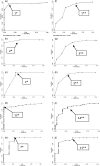CAGE, RAPS4, RAPS4-QF and AUDIT screening tests for men and women admitted for acute alcohol intoxication to an emergency department: are standard thresholds appropriate?
- PMID: 22414922
- PMCID: PMC3331621
- DOI: 10.1093/alcalc/ags027
CAGE, RAPS4, RAPS4-QF and AUDIT screening tests for men and women admitted for acute alcohol intoxication to an emergency department: are standard thresholds appropriate?
Abstract
Aims: A number of screening instruments are routinely used in Emergency Department (ED) situations to identify alcohol-use disorders (AUD). We wished to study the psychometric features, particularly concerning optimal thresholds scores (TSs), of four assessment scales frequently used to screen for abuse and/or dependence, the cut-down annoyed guilty eye-opener (CAGE), Rapid Alcohol Problem Screen 4 (RAPS4), RAPS4-quantity-frequency and AUD Identification Test (AUDIT) questionnaires, particularly in the sub-group of people admitted for acute alcohol intoxication (AAI).
Methods: All included patients [AAI admitted to ED (blood alcohol level ≥0.8 g/l)] were assessed by the four scales, and with a gold standard (alcohol dependence/abuse section of the Mini International Neuropsychiatric Interview), to determine AUD status. To investigate the TSs of the scales, we used Youden's index, efficiency, receiver operating characteristic (ROC) curve techniques and quality ROC curve technique for optimized TS (indices of quality).
Results: A total of 164 persons (122 males, 42 females) were included in the study. Nineteen (11.60%) were identified as alcohol abusers alone and 128 (78.1%) as alcohol dependents (DSM-IV). Results suggest a statistically significant difference between men and women (P < 0.05) in performance of the screening tests RAPS4 (≥1) and CAGE (≥2) for detecting abuse. Also, in this population, we show an increase in TSs of RAPS4 (≥2) and CAGE (≥3) for detecting dependence compared with those typically accepted in non-intoxicated individuals. The AUDIT test demonstrates good performance for detecting alcohol abuse and/or alcohol-dependent patients (≥7 for women and ≥12 for men) and for distinguishing alcohol dependence (≥11 for women and ≥14 for men) from other conditions.
Conclusion: Our study underscores for the first time the need to adapt, taking into account gender, the thresholds of tests typically used for detection of abuse and dependence in this population.
Figures

References
-
- Aertgeerts B, Buntinx F, Kester A. The value of the CAGE in screening for alcohol abuse and alcohol dependence in general clinical populations: a diagnostic meta-analysis. J Clin Epidemiol. 2004;57:30–9. - PubMed
-
- Allemand H, Villaume M, Deudon P, et al. étude épidémiologique de l'alcoolisation chez 3079 sujets admis consécutivement dans un service d'accueil urgence. Alcoologie. 1990;1:6–10.
-
- Allen JP, Litten RZ, Fertig JB, et al. Review of research on the Alcohol Use Disorders Identification Test (AUDIT) Alcohol Clin Exp Res. 1997;21:613–9. - PubMed
Publication types
MeSH terms
Grants and funding
LinkOut - more resources
Full Text Sources
Medical

